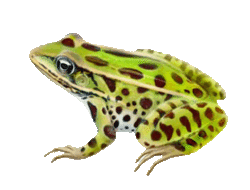Who are they?

The Northern Leopard Frog (Lithobates pipiens – formerly Rana pipiens) can be found in a variety of habitats, including marshlands, forests, agricultural areas and meadows. They are also well adapted to cold and can live in elevations up to 3,350 m. Like many amphibians, the Northern Leopard Frog is greenish brown in color. This species, however, is easily identified by the distinctive dark, circular spots speckled across its back and its legs. These spots differ on each individual, so no two leopard frogs are alike. This convenient trait makes it easier to identify individual frogs.
Their range is most of northern North America, except on the Pacific Coast. They generally live near ponds and marshes, but will often venture into well-covered grasslands as well, earning them their other common name, the meadow frog.
Leopard frogs will eat just about anything they can fit in their mouths. They sit still and wait for prey to happen by, then pounce with their powerful legs. They eat beetles, ants, flies, worms, smaller frogs, including their own species, and even birds, and garter snakes.
Their range is most of northern North America, except on the Pacific Coast. They generally live near ponds and marshes, but will often venture into well-covered grasslands as well, earning them their other common name, the meadow frog.
Leopard frogs will eat just about anything they can fit in their mouths. They sit still and wait for prey to happen by, then pounce with their powerful legs. They eat beetles, ants, flies, worms, smaller frogs, including their own species, and even birds, and garter snakes.
